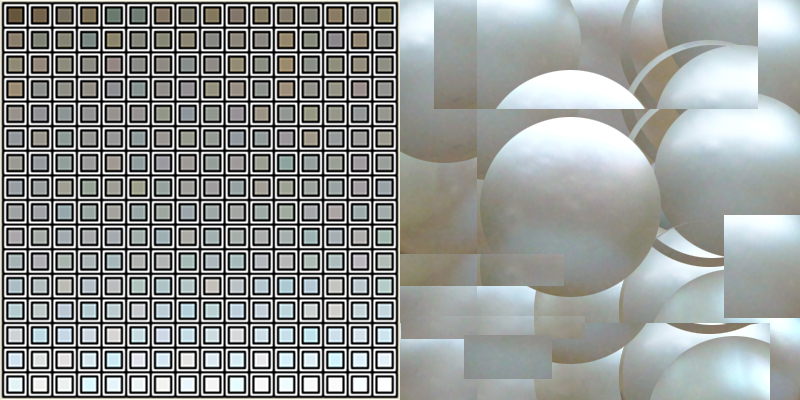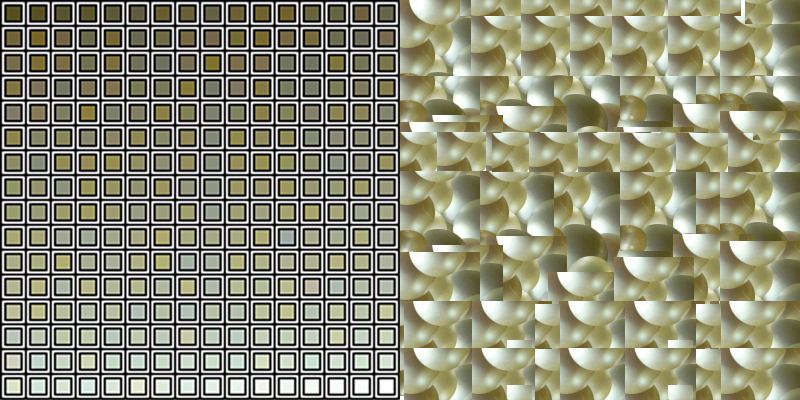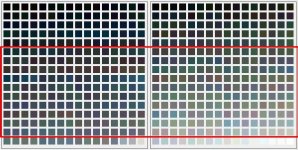You are using an out of date browser. It may not display this or other websites correctly.
You should upgrade or use an alternative browser.
You should upgrade or use an alternative browser.
Fun with color palettes!
- Thread starter Lagoon Island Pearls
- Start date
Lagoon Island Pearls
Well-known member
- Joined
- Dec 8, 2009
- Messages
- 2,117
Wouldn't another possibility be as many variations, but a color shift - toward a more pink version of the same colors? You know, similar to the effects you get when you 'cool' or 'warm' the tint of a photo in computer editing.
There will always be some color shift when light is applied to reflective or refractive surfaces. For example, if I had a rainbow colored cloth, then dyed it blue, you end up with a blue cloth.
Dyes, stains and inks will invariably lengthen a color's frequency interval while reducing wavelength. In lay terms, that means eliminating colors in between. You'll end up with sharper contrasts, but less variations.
Bleaching will do the opposite, but to the same detriment. It will decrease the color's frequency interval while extending the wavelength. Either way, dying or bleaching narrows the number of colors present.
Attachments
Lagoon Island Pearls
Well-known member
- Joined
- Dec 8, 2009
- Messages
- 2,117
So I've had a play with the pics above, my Photoshop 7 only sorts the colors by Luminescence
First the Naturals, then the Mikimotos


The natural colors in the first image look great. You can clearly see both greens and reds... either end if the spectrum.
The second image not so much, likely because of the lighting when the photo was taken.
lisa c
Perpetual Pearl Student
- Joined
- Jun 28, 2009
- Messages
- 3,600
Sorry Kiwi, didn't mean to cause inconvenience. Maybe it doesn't matter. Any purpose to taking clumped pearl photos, Dave? Was I just getting too baroque in my thinking/suggestion?
Last edited:
Lagoon Island Pearls
Well-known member
- Joined
- Dec 8, 2009
- Messages
- 2,117
I think the term we are looking for in natural colors is "mid-range". Multiple mid-range variations are a good indicator of natural colors in pearls. As you saw in the palettes of dyed or bleach akoyas, mid-range colors are limited or non-existent, having been pushed to their extremes.
Lagoon Island Pearls
Well-known member
- Joined
- Dec 8, 2009
- Messages
- 2,117
Lagoon Island Pearls
Well-known member
- Joined
- Dec 8, 2009
- Messages
- 2,117
Any purpose to taking clumped pearl photos, Dave?
Yes. The purpose is eliminate background colors and minimize shadows.
As I've mentioned before, this is a subjective experiment. To be effective, we'd need to get the most realistic impression possible in the mosaics.
FrenchPearl
Member
- Joined
- Feb 9, 2013
- Messages
- 155
I'm starting to get on board with this tool. The number of unique colors in the mid range really makes it for me as a great indicator for naturals
This is wayyyyyyy cool for the newbie natural pearls collector (and treasure hunter on ebay ;-) I am.
I'm still struggling with the candling technique and here is another way to get lost in the pearl world....
Thanks Dave, love your out-of -the box / creative brain
Sophie
This is wayyyyyyy cool for the newbie natural pearls collector (and treasure hunter on ebay ;-) I am.
I'm still struggling with the candling technique and here is another way to get lost in the pearl world....
Thanks Dave, love your out-of -the box / creative brain
Sophie
Lagoon Island Pearls
Well-known member
- Joined
- Dec 8, 2009
- Messages
- 2,117
On first impression, it may not appear to have thousands of unique colors in a 256 color image. It's important to remember it's a result of all possible combinations between any or all of the colors present.
FrenchPearl
Member
- Joined
- Feb 9, 2013
- Messages
- 155
Yep, got it. Still a valuable indicator.
Did you find out other "variables" ? Like the number of cropped images in the mosaic?
I'm assuming this method would only be valid for pearls on white background ?
It also took me a while to realise that some pearls with high luster were reflecting the color of the clothes I was wearing.. Would that impact the result ? In professional photo, i often seen the black reflection of the camera on the pearl
Did you find out other "variables" ? Like the number of cropped images in the mosaic?
I'm assuming this method would only be valid for pearls on white background ?
It also took me a while to realise that some pearls with high luster were reflecting the color of the clothes I was wearing.. Would that impact the result ? In professional photo, i often seen the black reflection of the camera on the pearl
Lagoon Island Pearls
Well-known member
- Joined
- Dec 8, 2009
- Messages
- 2,117
Did you find out other "variables" ? Like the number of cropped images in the mosaic?
A very good question. The mosaics do not need to be as elaborate as kiwipaul posted, because much of the same imaging is repeated. In the case of Dawn's Tahitian pearl, I used an elliptical selector and pasted it to an alpha (transparent background)
I'm assuming this method would only be valid for pearls on white background ?
Background colors and their reflections will skew the results. No background and less shadow is preferred.
It also took me a while to realise that some pearls with high luster were reflecting the color of the clothes I was wearing.. Would that impact the result ? In professional photo, i often seen the black reflection of the camera on the pearl
Another excellent point. Yes, reflected colors can skew the results. This is why I prefer to use mosaics as opposed to single images, because known foreign colors can be eliminated from them.
Hence the subjectivity of the experiment. This could only become objective if we used calibrated lighting and camera settings to create a database of exemplars across the spectrum of all pearls.
I certainly do not have those resources available to me, but perhaps Jeremy might be so kind as to invite me into his vault one time to create one.
Last edited:
FrenchPearl
Member
- Joined
- Feb 9, 2013
- Messages
- 155
Funny, a database of palette was also what was running through my mind
That and the fact that i should wear the same shirt when I re-photograp my pearls ;-)
Would be great if Jeremy was interested... This idea has really potential
That and the fact that i should wear the same shirt when I re-photograp my pearls ;-)
Would be great if Jeremy was interested... This idea has really potential
kiwipaul
Community member
- Joined
- May 21, 2013
- Messages
- 195
This is wayyyyyyy cool for the newbie natural pearls collector (and treasure hunter on ebay ;-) I am.
Hi Sophie, unfortunately it's probably not so useful for eBay treasure hunting.
Problem is most people's photos on eBay are total rubbish, taken in unsuitable lighting against weird backgrounds, and so they'd be unusable.
FrenchPearl
Member
- Joined
- Feb 9, 2013
- Messages
- 155
Yes, you're absolutely right. The ebay item I was just thinking about is photographed on a red background ;-)
However, that method could be useful for items i've already purchased, and that I'm still studying.
I think i got lucky last month with that small pearls necklace, and i'm going to try to do the "fun color palette" with it tonight
https://www.pearl-guide.com/forum/showthread.php?t=8284
Sophie
However, that method could be useful for items i've already purchased, and that I'm still studying.
I think i got lucky last month with that small pearls necklace, and i'm going to try to do the "fun color palette" with it tonight
https://www.pearl-guide.com/forum/showthread.php?t=8284
Sophie
kiwipaul
Community member
- Joined
- May 21, 2013
- Messages
- 195
So can I ask a question of Dave about this Naturals colour palette.
First of all let me say I am not great with colors, my wife and daughter tell me this all the time.
However it seems to me that there is a distinct blue tinge in the palette and visible in the pic of these naturals.

I recall this pic was taken in natural sunlight.
The blue (if it really is there) seems to me to be associated with the luster, that silvery sheen characteristic of clean reasonably high quality naturals.
The other possible source of the blue in this pic is the blue velvet case the pearls were in.
The lining was cream, but the blue outer edge of the case could have been picked up by the pearls.
So Dave, is blue part of naturals' color profile, or has it snuck in from a reflection?
P.S. I've now looked back at the original post and pics of the naturals, the inside of the case has white linen strip running inside the blue velvet outer, so I don't think the pearls could've picked up the blue reflection from the case.
https://www.pearl-guide.com/forum/showthread.php?t=7810
First of all let me say I am not great with colors, my wife and daughter tell me this all the time.
However it seems to me that there is a distinct blue tinge in the palette and visible in the pic of these naturals.

I recall this pic was taken in natural sunlight.
The blue (if it really is there) seems to me to be associated with the luster, that silvery sheen characteristic of clean reasonably high quality naturals.
The other possible source of the blue in this pic is the blue velvet case the pearls were in.
The lining was cream, but the blue outer edge of the case could have been picked up by the pearls.
So Dave, is blue part of naturals' color profile, or has it snuck in from a reflection?
P.S. I've now looked back at the original post and pics of the naturals, the inside of the case has white linen strip running inside the blue velvet outer, so I don't think the pearls could've picked up the blue reflection from the case.
https://www.pearl-guide.com/forum/showthread.php?t=7810
Last edited:
Lagoon Island Pearls
Well-known member
- Joined
- Dec 8, 2009
- Messages
- 2,117
it seems to me that there is a distinct blue tinge in the palette and visible in the pic of these naturals...
The blue (if it really is there) seems to me to be associated with the luster, that silvery sheen characteristic of clean reasonably high quality naturals.
The other possible source of the blue in this pic is the blue velvet case the pearls were in.
The lining was cream, but the blue outer edge of the case could have been picked up by the pearls.
So Dave, is blue part of naturals' color profile, or has it snuck in from a reflection?
Perhaps you've answered your own question, but it's still a good point for discussion.
The whites at the base of the palette are reflected light, the mid-range above are overtones. Outdoors, especially if the day is clear you run the possibility of reflections from the sky. This is why it's advisable to photograph pearls in a shaded area.
Again, much of this comes down to the quality of the image, especially when it comes to balanced light.
It's reasonable to assume there will be color shift, after all pearls have orient. Likewise we seldom see pearls worn in perfect lighting conditions.
Even though some colors are not true colors, they are perceived colors nonetheless. We all know the sky really isn't blue, nor is the ocean. Incidentally, neither are blue jays. They only appear blue.
So although a color may not truly be, it's still remarkable to have the perception of it. That's a good thing when it comes to pearls, because they are doing what they're supposed to be doing, and that is impressing us!
lisa c
Perpetual Pearl Student
- Joined
- Jun 28, 2009
- Messages
- 3,600
Yes, I understand now  thanks to your elaboration. Thank you for taking the time to illustrate your explanation
thanks to your elaboration. Thank you for taking the time to illustrate your explanation .
.
So, to extrapolate - you can use the numbers from your program analysis as well as your visual chart to decide that pearls are treated or untreated. Untreated will have many more colors than treated, and it seems to be to an exponential degree?
So, to extrapolate - you can use the numbers from your program analysis as well as your visual chart to decide that pearls are treated or untreated. Untreated will have many more colors than treated, and it seems to be to an exponential degree?
Last edited:
Lagoon Island Pearls
Well-known member
- Joined
- Dec 8, 2009
- Messages
- 2,117
So, to extrapolate - you can use the numbers from your program analysis as well as your visual chart to decide that pearls are treated or untreated. Untreated will have many more colors than treated, and it seems to be to an exponential degree?
Yes, the math speaks volumes.
I'd have to admit that when I undertook this this experiment, post harvest treatment wasn't a consideration any further than black dye. My target was to identify the subtle differences between species.
Had others not questioned my methods, we might have missed the point.
This is the beauty of science because sometimes we'll have eureka moments when we least expect it.
Last edited:
lisa c
Perpetual Pearl Student
- Joined
- Jun 28, 2009
- Messages
- 3,600
Oh yes, Beauty of Science! - and tutorials! Nothing like having to teach something for sharpening focus and at the same time expanding it.
Honestly, if someone doesn't get a paper, or mention in Strack out of this, I'll be shocked. Shocked, I tells ya!
Honestly, if someone doesn't get a paper, or mention in Strack out of this, I'll be shocked. Shocked, I tells ya!
Lagoon Island Pearls
Well-known member
- Joined
- Dec 8, 2009
- Messages
- 2,117
Oh yes, Beauty of Science! - and tutorials! Nothing like having to teach something for sharpening focus and at the same time expanding it.
Honestly, if someone doesn't get a paper, or mention in Strack out of this, I'll be shocked. Shocked, I tells ya!
You are too kind, Lisa.
However, I'm afraid I am a little rough around the edges for the erudite that is Ms. Strack.
Similar threads
- Replies
- 22
- Views
- 2K
- Sticky
- Replies
- 12
- Views
- 1K
- Replies
- 4
- Views
- 6K
- Replies
- 382
- Views
- 48K


